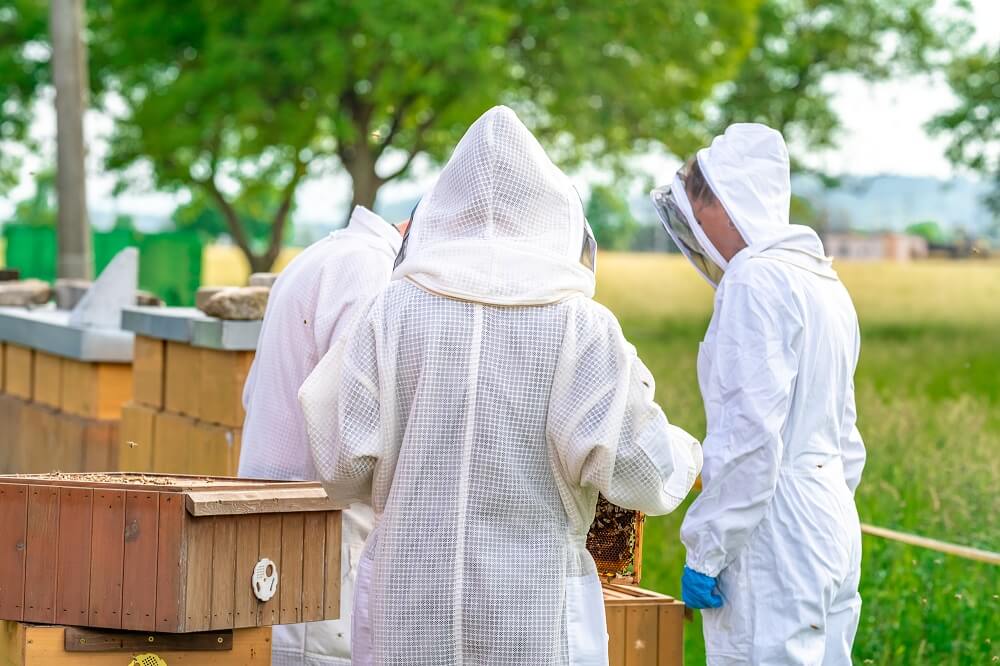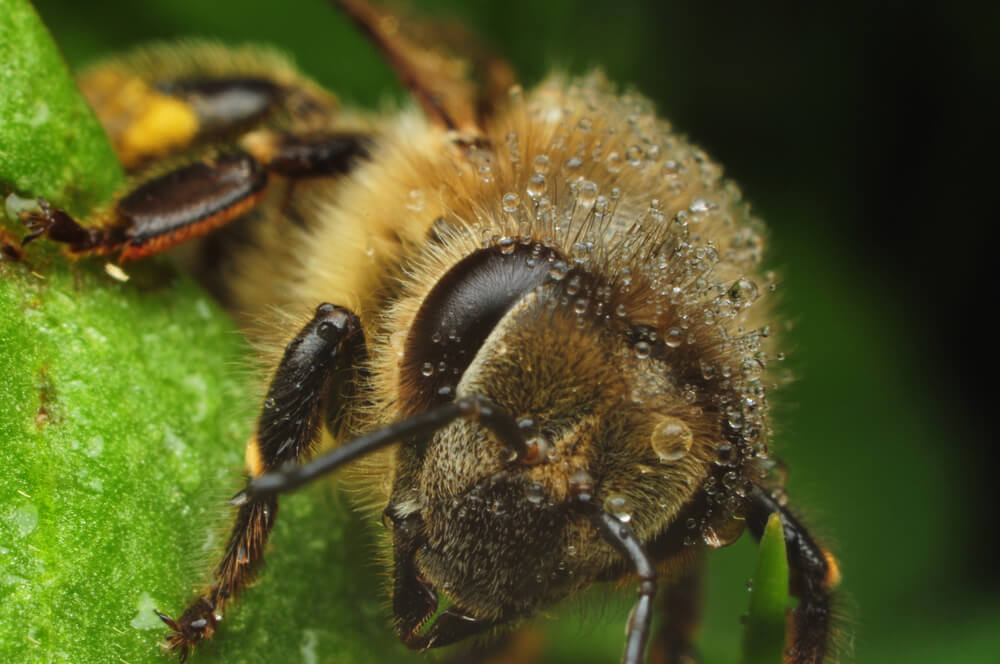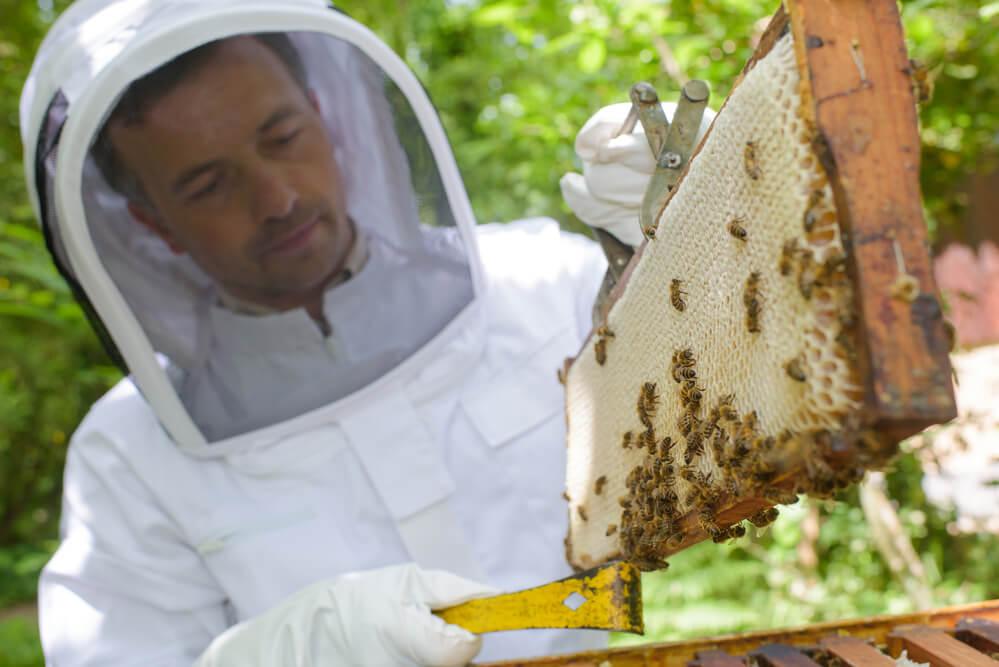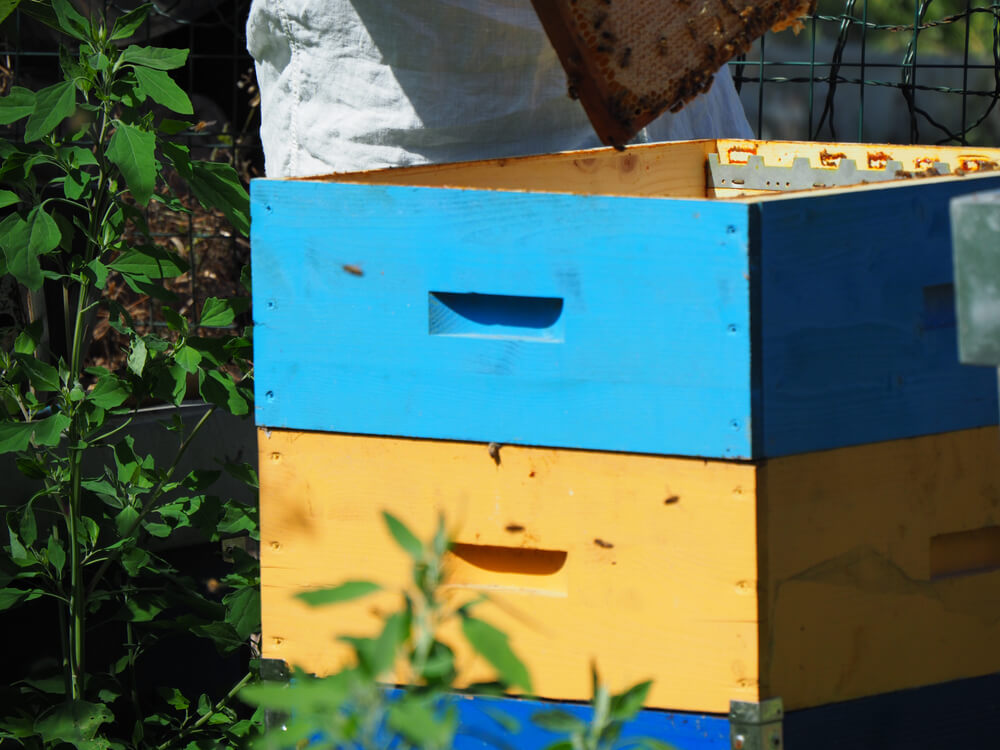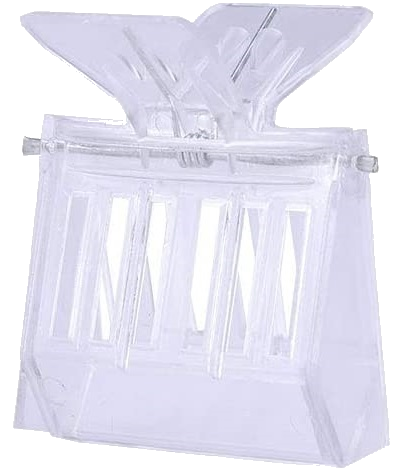Table of Contents:
How to Find a Queen Bee: What Does a Queen Bee Look Like?
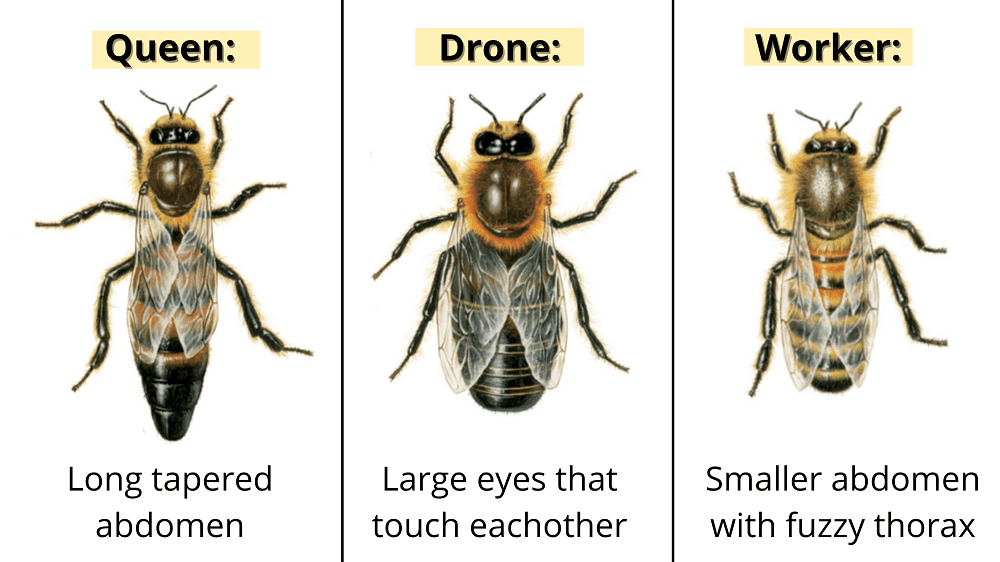
There are two key differences between queens and the other bees. They are:
- The queen’s abdomen is longer
- The queen’s upper back (thorax) is shiny, dark, and hairless
Now you might be asking…
Isn’t the queen bee larger than the other bees?
Yes, but only slightly.
In fact, you need to know something right off the bat:
The queen bee isn’t as big as you might think. She’s only slightly bigger than the worker bees (females) and just a hair bigger than the drone bees (males).
You see, it’s really the queen’s abdomen and thorax that distinguishes her – not necessarily her size.
Take a look at this example:

So what am I telling you?
Don’t try to spot your queen solely based on size. That’ll have you searching forever because some queens are smaller than others. Instead, focus on identifying her by her abdomen and thorax.
Check out this video on queen bee spotting:
Now here’s the thing:
Once you learn to identify the queen by her appearance, you can also notice how she moves. For example, you’ll see that the queen “barrels” across the frame as she walks. She moves with a purpose and charges through the worker bees.
As she walks, the worker bees usually move out of her way and leave an empty wake behind her. Her movement can create a visual break in the hive.
But what about if she’s not moving?
A resting queen will be surrounded by worker bees that are facing her.
Like this:

Can you spot the queen above?
She’s in the middle of several worker bees that are all facing her.
Last but not least?
Remember that your queen’s job is to lay eggs. Lots of them.
So she spends most of her time in the nursery and not on the frames filled with honey. So look for your queen in the brood frames first.
Related: Backyard Beekeeping: The One Thing You Should Do First
How to Mark Your Queen Bee
Let’s face it.
Finding the queen bee isn’t always easy.
That’s why both beginner and experienced beekeepers mark their queens with a colored pen.
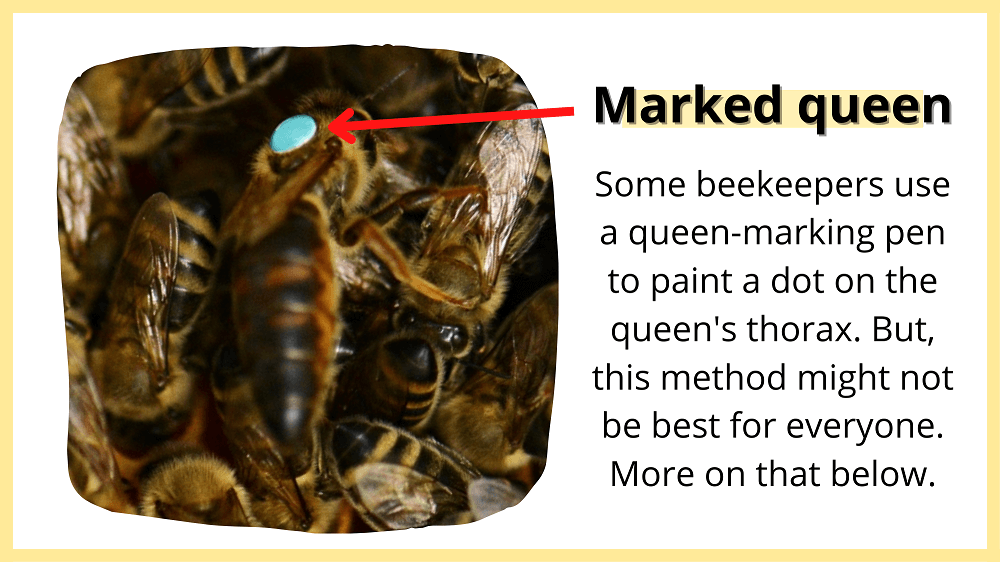
But this is where the age-old debate comes in…
To mark my queen or not mark my queen?
One camp argues that marking your queen is worth it because it makes her easier to find and saves you time. The other camp says it handicaps your ability to find your queen based on her physical features. The bright spot of paint becomes a “crutch,” as they say.
My opinion?
Don’t mark your queen.
And I’ll shoot straight with you:
My stance on that has little to do with it becoming a “crutch.” Instead, it has everything to do with the queen’s safety. If you accidentally get paint on her head or abdomen, it can cause damage to her.
For example, I recently got an email from a new beekeeper who said he accidentally blinded his new queen while marking her. The queen-marking pen released too much ink, the queen moved, and he got some paint on her head.
Here’s an example:
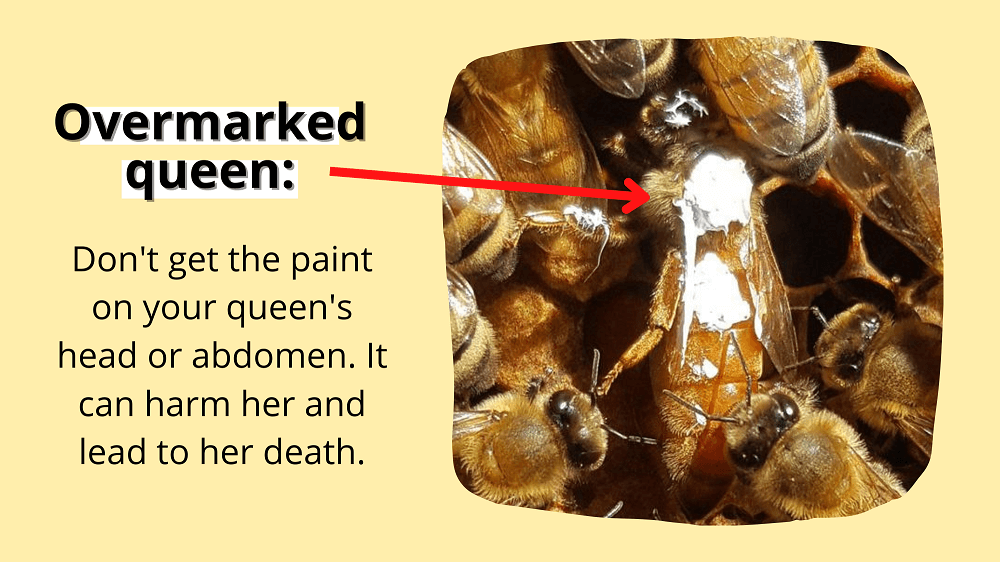
Not good.
To me, it’s not worth the risk. Just get better at spotting your queen.
That said, there are some benefits to marking your queen. And even though I don’t recommend it, I owe it to you to discuss it so you get both sides.
For starters, marking your queen can save you time when spotting her – especially as a newbie. Secondly, it allows you to easily keep up with your queens’ age and whether she’s been replaced or not.
(Although, an observant beekeeper will usually notice signs of a replacement queen anyway).
Beekeepers use a color guide to keep up with their queen’s age. The color of the dot depends on which year the queen was born.
International Queen-marking Colors
Years ending in:
- 1 or 6 – White Dot
- 2 or 7 – Yellow Dot
- 3 or 8 – Red Dot
- 4 or 9 – Green Dot
- 5 or 0 – Blue Dot
For example, queens born in 2022 will have a yellow dot. And queens born in 2023 will have a red dot.
Simple enough, right?
But, before marking your queen, there are a few things to consider:
- All paint pens aren’t created equally. Don’t use oil-based pens. Use water-based, non-toxic paint pens like these.
- Make sure you blot the end of your paint pen first. Sometimes pens can release a splotch of ink all at once, leaving your queen drenched in paint. Blot the tip on a paper towel first to ensure this doesn’t happen.
- Practice on drone bees first. Use a different color and practice on at least a dozen drones. This will give you a feel for how to mark a bee.
- Wait until the paint dries before releasing her back to the hive. Set the queen catcher on top of the frames for a few minutes, so the paint dries.
Now, I understand that many people are visual learners. So check out this video on how to mark a queen:
Related: The 3 Best Bee Suits for 2022
Should You Find Your Queen Bee During Every Inspection?
Not necessarily.
I understand that spotting the queen amongst thousands of other bees is tricky. You have to be quick because queens sometimes hide during inspections.
Why?
Because the longer you have your hive open, the more likely your bees will feel disturbed. Your queen will flee into a corner for safety if she feels the hive is disturbed.
And when this happens, you may just have to pack it up and come back another day.
In the meantime, you’ll need to look for signs of a laying queen. For example, you should always check for fresh eggs during your hive inspection. You can do so by holding the frame up to the sunlight and trying to spot the eggs.
(If you’re using foundationless, be careful not to break the comb when holding it up).
You can also grab a magnifying glass to help you spot eggs.
Here’s a video of how to spot eggs:
If you can find signs of a laying queen, you won’t have to find her during every inspection.
Related: How Many Bees Are in a Hive?
FAQs on “What Does a Queen Bee Look Like?”
- Should I buy a queen that’s already pre-marked?
- Do I need to follow a hive procedure when queen spotting?
- What if I can’t find my queen?
- What are the signs that my colony is queenless?
Should I buy a queen that’s already pre-marked?
Sure, this can be a good idea for beginners. That way, the bee sellers handle the marking, and you don’t have to worry about accidentally harming your queen.
It usually costs around $10 extra for a pre-marked queen. But it can be a good investment when you’re starting out because it gives you one less thing to worry about. There’s a lot to learn in the first year of beekeeping.
Later on, you can decide if you want to continue marking queens or not.
That said, buying a marked queen isn’t always foolproof. Remember, the worker bees tend to the queen 24/7. They clean her, feed her, and protect her. This means they’ll sometimes end up cleaning the paint off their queen.
—> Go back to the “What does a queen bee look like?” FAQs
More to Explore:
Do I need to follow a hive procedure when queen spotting?
Yes, I recommend developing a routine for hive inspections. This will help you work more efficiently and ensure you’re checking all your bases. Every beekeeper will have their own way of doing things.
Here’s an example of a queen-spotting routine:
- Step one: Lightly smoke the hive entrance. The key here is to use a bee smoker with cool, white smoke. And don’t overdo it. It only takes a few puffs of smoke to do the trick.
- Step two: Wait a few minutes to allow the smoke to disrupt the alarm pheromones of the colony.
- Step three: Remove the telescoping top and use a hive tool to pry the inner cover off. Lay the cover aside. Super boxes are removed in the same way and placed aside. Give a few puffs of smoke occasionally to make the inspection easier.
- Step four: Inspect the deep brood box first (the one on the bottom). This is where the queen will most likely be found because she’ll be laying eggs. If you don’t find her in the bottom box, move to the next box higher, and so on.
- Step five: if you can’t lay eyes on your queen, then try to find signs of her (fresh eggs & young larvae) These signs reassure you that your queen is doing her job.
—> Go back to the “What does a queen bee look like?” FAQs
More to Explore:
- How Many Bees Are in a Hive?
- What is Backyard Beekeeping?
- Honey Extractors 101: Everything You Need to Know
What if I can’t find my queen?
People often ask how to find a queen bee as a beginner or how to find the queen bee if you’ve been unsuccessful in the past.
Here’s your answer:
Don’t worry if you don’t find the queen bee every time. As long as you see signs of the queen, such as fresh eggs and young larvae, you don’t have to lay eyes on her during each inspection.
It’s not uncommon for the queen to hide once you show up. Bees sometimes feel exposed or disturbed once you open their hive. This can trigger the queen to go into hiding. For this reason, you usually have to work quickly to find your queen.
—> Go back to the “What does a queen bee look like?” FAQs
More to Explore:
What are the signs that my colony is queenless?
Good question.
I’ll give you a few pointers. And as you get more experienced, you’ll become better at recognizing the signs.
And keep in mind:
It’s always smart to befriend local beekeepers before starting your new hobby. They can help guide you through hive inspections, honey harvesting with a honey extractor, or handling issues such as queenless hives.
That said, now let’s get some housekeeping out of the way:
A hive without a queen is called “queenless,” and a hive with a queen is called “queenright.”
If the queen dies unexpectedly, the worker bees only have a limited time to raise a new queen. If the old queen’s larva gets too old, then the colony won’t be able to make a new queen.
With that in mind, here are a few signs that you have a queenless hive:
- Lack of eggs and brood. The queen is the only bee that can lay fertilized worker bee eggs. So pay attention to a lack of eggs and young brood. (That said, sometimes you can lack new eggs/brood and still have a queen. This can happen when your queen is no longer fertile, or taking a “brood break.” Queens taking a brood break will begin laying eggs shortly. Infertile queens will need to be replaced.)
- Your worker bees appear stressed. The fate of your colony depends on a healthy queen. If your bees become queenless unexpectedly, it can send them into a panic. They often make a high-pitched whine combined with a low roar during high-stress times.
- Your colony’s population is declining. During the peak months, you can lose up to 1,000 worker bees per day due to natural causes. It’s normal. But, these workers need to be replaced by new eggs. So if you notice your colony’s population is declining, this could be a sign that your hive has been queenless for several weeks.
- There is more honey and pollen production. Worker bees who were previously responsible for caring for brood will soon be out of the job if they don’t have a queen. This creates a job imbalance where they start foraging or producing more honey. (Increased honey production can also happen when a hive becomes “honey bound.” This happens during a strong nectar flow when the colony needs more space. The bees start storing more honey and eventually crowd out the queen’s brood nest, giving her no room to lay new eggs. You can fix this by adding another super or top bars and then moving 2-4 honey frames out of the brood nest. This makes room for the new comb to be drawn out for the queen to lay eggs in.)
- You see empty queen cells. If your colony has lost its queen but can’t replace her, you may notice empty cells. This is because your bees don’t have the fertilized eggs needed to replace the queen.
- Laying worker bees. Worker bees may start laying unfertilized eggs if their hive is queenless. Normally, worker bees don’t lay eggs if they have a queen. Once worker bees start laying, it can be hard to get the colony queenright again.

